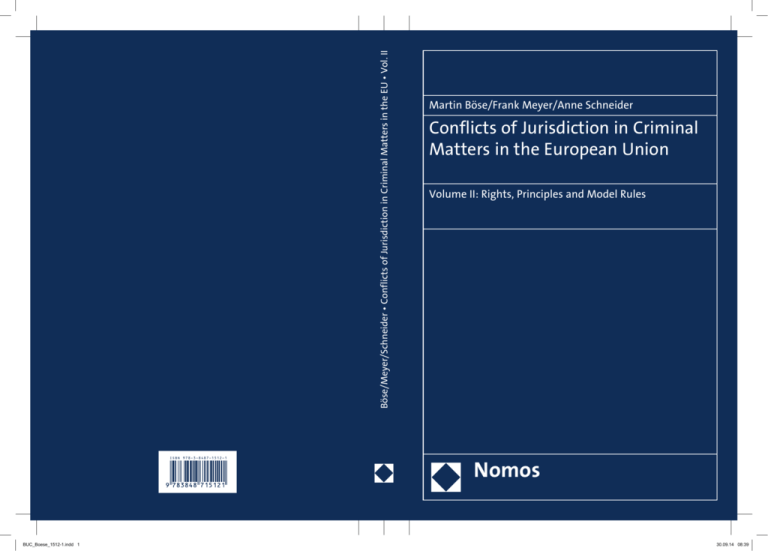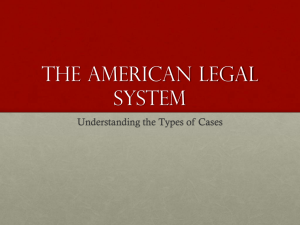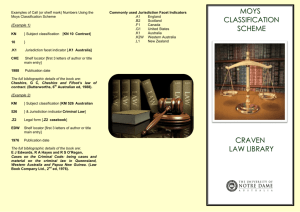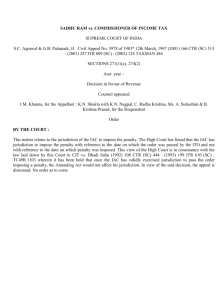
Böse/Meyer/Schneider • Conflicts of Jurisdiction in Criminal Matters in the EU • Vol. II
ISBN 978-3-8487-1512-1
BUC_Boese_1512-1.indd 1
Martin Böse/Frank Meyer/Anne Schneider
Conflicts of Jurisdiction in Criminal
Matters in the European Union
Volume II: Rights, Principles and Model Rules
Nomos
30.09.14 08:39
http://www.nomos-shop.de/23140
Prof. Dr. Martin Böse/Prof. Dr. Frank Meyer/
Dr. Anne Schneider
Conflicts of Jurisdiction in Criminal
Matters in the European Union
Volume II: Rights, Principles and Model Rules
Nomos
BUT_Boese_1512-1.indd 3
21.08.14 14:18
http://www.nomos-shop.de/23140
Die Deutsche Nationalbibliothek lists this publication in the
Deutsche Nationalbibliografie; detailed bibliographic data
is available in the Internet at http://dnb.d-nb.de
ISBN
978-3-8487-1512-1 (Print)
978-3-8452-5553-8 (ePDF)
British Library Cataloguing-in-Publication Data
A catalogue record for this book is available from the British Library.
ISBN
978-3-8487-1512-1 (Print)
978-3-8452-5553-8 (ePDF)
Library of Congress Cataloging-in-Publication Data
Böse, Martin/Meyer, Frank/Schneider, Anne
Conflicts of Jurisdiction in Criminal Matters in the European Union
Vol. II
Martin Böse/Frank Meyer/Anne Schneider
ca. 481 p.
Includes bibliographic references.
ISBN
978-3-8487-1512-1 (Print)
978-3-8452-5553-8 (ePDF)
1. Edition 2014
© Nomos Verlagsgesellschaft, Baden-Baden, Germany 2014. Printed and bound in Germany.
This work is subject to copyright. All rights reserved. No part of this publication may be
reproduced or transmitted in any form or by any means, electronic or mechanical,
including photocopying, re-cording, or any information storage or retrieval system,
without prior permission in writing from the publishers. Under § 54 of the German
Copyright Law where copies are made for other than private use a fee is payable to
“Verwertungs­gesellschaft Wort”, Munich.
No responsibility for loss caused to any individual or organization acting on or refraining from action as a result of the material in this publication can be accepted by Nomos
or the author(s)/editor(s).
BUT_Boese_1512-1.indd 4
21.08.14 14:18
http://www.nomos-shop.de/23140
Table of Contents
Table of Cases
14 Chapter 1: Introduction (Böse/Meyer/Schneider)
A. Course of the study
B. Jurisdiction
I. Concepts of Jurisdiction
1. Jurisdiction to prescribe, to adjudicate and to enforce
a) Jurisdiction to prescribe (substantive law dimension)
b) Jurisdiction to adjudicate and to enforce (procedural
dimension)
2. Primary and derivative jurisdiction
a) Primary Jurisdiction
b) Derivative Jurisdiction
II. Types and elements of rules on jurisdiction
1. Multilateral and unilateral rules
2. Connecting factors and subject matter
a) Subject matter
b) Connecting factors
C. Criminal Law
I. The structure of criminal law provisions
1. The theory of norms
2. Terminology
3. Conduct-regulating norms
4. Sanctioning norms
II. The Definition of Criminal Sanctions in the EU
21 21 22 22 22 23 Part I: Extraterritorial Jurisdiction and Fundamental Rights
41 23 24 24 25 26 26 27 28 28 29 30 30 31 33 34 34 Chapter 2: Fundamental freedoms of the Union (Böse)
43 A. Fundamental freedoms of market participants or European
citizens?
43 B. The principle of non-discrimination (Art. 18 TFEU)
44 I. The passive personality principle
45 1. Scope of application
45 2. (Illegitimate) Discrimination ?
52 a) Protection of nationals by means of criminal law (jurisdiction to
prescribe)
53 7
http://www.nomos-shop.de/23140
Table of Contents
b) Victims’ participation in criminal proceedings (jurisdiction to
enforce)
II. The active personality principle
1. Scope of application
2. Reverse discrimination of nationals (jurisdiction to
prescribe)
3. Reverse discrimination and justification
4. Discrimination of non-nationals (jurisdiction to
adjudicate)
C. Freedom of movement (Art. 21 TFEU)
I. Extraterritorial jurisdiction as a restriction on the right
of free movement
II. Justification
1. Cross-border criminality and effects principle
2. The protective principle
3. The passive personality principle
4. The active personality principle
5. Universal jurisdiction
6. Principle of representational jurisdiction
III. Conclusion
Chapter 3: Fundamental Rights of the EU-Charter (Böse)
A. Scope of the Charter
B. Nullum crimen, nulla poena sine lege (Art. 49 CFR)
I. Jurisdictional rules outside the scope of the legality principle?
II. Nullum crimen, nulla poena sine lege and extraterritorial
jurisdiction
1. The effects principle
2. The protective principle
3. The active personality principle
4. The passive personality principle
5. Universal jurisdiction
6. The principle of representation
III. Conclusion
C. Nullum iudicium sine lege (Art. 47 para. 2 CFR)
I. Convergence of procedural and substantive legality?
II. Derivative and concurring jurisdiction and the lawful judge
concept
D. Ne bis in idem (Art.50 CFR)
I. The reservations under Art. 55 CISA
II. Discontinuation of the reservations under Art. 55 CISA?
1. Integration of the Schengen acquis into EU law
2. Derogation by Art. 50 CFR
8
57 58 59 60 63 69 72 73 75 75 83 87 91 99 103 104
107
107 109 109 111 114 115 117 118 119 120 124 124 124 126 129 131 133 133 135 http://www.nomos-shop.de/23140
Table of Contents
III. Conformity of the reservations under Art. 55 CISA
with Art. 50 CFR
1. The requirement of a legal basis
2. The principle of proportionality
a) Art. 55 para. 1 lit. a CISA (territoriality)
b) Art. 55 para. 1 lit. b CISA (protection of essential state
interests)
c) Art. 55 para. 1 lit. c CISA (violation of official duties)
IV. Conclusion
E. Fundamental Rights and EU legislation
I. The ne bis in idem principle (Art. 50 CFR)
II. The lawful judge guarantee (Art. 47 para. 2 CFR)
1. The transnational dimension of Art. 47 para. 2 CFR
2. The determination of the (international) forum
III. The principle nullum crimen, nulla poena sine lege
(Art. 49 para. 1 CFR)
IV. Conclusion
Chapter 4: An Area of Freedom, Security and Justice (Meyer)
A. Policies and Tasks
B. The Stockholm Programme and its succession
C. Unfulfilled promises
I. The meaning of freedom, security and justice
II. An originalist view
III. A more constructivist view
D. Dimensions of freedom of movement
I. Restrictive dimension
II. Justifications
E. Beyond mobility!
I. Empowering the citizen
II. Scope of Application of the CFR
III. Dimensions of protection
1. Positive obligations
2. Conclusion
IV. Fundamental Rights
1. Substantive rights
a) Art. 6 CFR
b) Art. 7 CFR
c) Art. 11 CFR
2. Procedural Rights
a) Legality
b) Fair trial
aa) nullum iudicium sine lege
137 137 139 140 142 145 146 147 148 151 152 160 164 167
169
169 172 173 174 175 177 179 179 183 185 185 187 189 190 192 193 193 193 194 200 201 202 205 205 9
http://www.nomos-shop.de/23140
Table of Contents
bb) Lawful judge concept
F. Conclusions
G. Obligations
207 209 210 Part II: Private Law Solutions and their Transferability to Criminal Law 215 Chapter 5: The basic approach to jurisdiction in private and criminal
law (Schneider)
A. Introduction
B. The basic principle for treating conflicts of jurisdiction
I. Overview of civil jurisdiction
II. Overview of criminal jurisdiction
III. Comparison
C. Admissibility of distinguishing between jurisdiction to prescribe and
jurisdiction to adjudicate in criminal law
I. The application of foreign criminal law
1. Sovereignty
a) The adjudicating state
b) The penalising state
c) Dignity of the state
2. The nature of punishment
a) The definition of punishment
b) Justice
c) Legitimacy of punishment
d) Comparison with similar constructions
aa) Representation in conflicts of jurisdiction in criminal
matters
bb) Punitive damages
3. The intertwinement of substantive and procedural criminal law
4. Nulla poena sine lege
a) Principle of clarity
b) Democratic legitimacy
5. Practical problems
a) The discovery of foreign criminal law
b) The difference of sanctions
6. Conclusion
II. Lack of jurisdiction to adjudicate when national criminal law
applies
III. Conclusion
D. Desirability of distinguishing between jurisdiction to prescribe and
jurisdiction to adjudicate in criminal law
I. Justice
II. Increased flexibility and legality
10
217 217 218 218 220 221 222 223 224 224 226 227 229 230 233 234 236 236 239 244 247 248 250 252 252 255 258 258 261 261 262 262 http://www.nomos-shop.de/23140
Table of Contents
III. Better protection of the interests of the defendant
IV. Expression of mutual recognition
V. Conclusion
Chapter 6: Analysis of connecting factors (Schneider)
A. Connecting factors in procedural law
I. Civil jurisdiction to adjudicate
1. The general rule
2. Special jurisdiction for torts
3. Violation of personality rights
4. Adhesive procedures
5. Prorogation of jurisdiction
6. Conclusion
II. Transfer to criminal jurisdiction to adjudicate
1. Domicile
a) Of the defendant
b) Of the victim
2. Place where the harmful event occurred
3. Adhesive procedures
4. Prorogation of jurisdiction
a) Possible parties to the agreement
b) Extent of the prorogative agreement
5. Conclusion
B. Connecting factors in substantive law
I. Civil jurisdiction to prescribe – the applicable law
1. The general rule (Art. 4)
2. Specific rules (Articles 5-9)
3. Choice of law (Art. 14)
4. Rules of safety and conduct (Art. 17)
5. Conclusion
II. Transfer to criminal jurisdiction to prescribe
1. General and specific rules on jurisdiction to prescribe
2. Place where the damage occurs
3. Place of action
4. Place where the damage was foreseeable/intended to occur
5. Common habitual residence
6. Manifestly closer connection with another country
7. Choice of law
8. Conclusion
C. Final observations
263 265 265
267
267 267 268 268 270 272 273 274 274 275 275 276 278 282 283 284 286 288 289 289 289 291 293 293 294 295 296 297 297 299 302 303 304 304 305
11
http://www.nomos-shop.de/23140
Table of Contents
Chapter 7: The relevance of foreign law for interpreting criminal law
(Schneider)
A. Introduction
B. Elements open for interpretation by foreign law
I. Areas in the literature where the relevance of foreign law
is considered
II. The relationship between these areas
1. Blanket clauses
2. Legal standards
3. Normative elements and preliminary questions
C. Relevance of foreign law
I. Blanket clauses
II. Legal standards
III. Normative elements and preliminary questions
1. Preliminary questions in conduct-regulating norms
2. Preliminary questions in other norms
D. Final observations
Part III: Legal Instruments and Model Rules
307
307 307 308 310 310 313 314 318 319 319 323 323 327 329 333 Chapter 8: Models and instruments for solving conflicts of jurisdiction
(Böse)
335
A. The legal framework of the European Union
335 I. Vertical coordination (Eurojust and the European Public
Prosecutor)
335 1. The role of Eurojust
336 2. Eurojust guidelines on how to determine the jurisdiction “best
placed” for prosecution
337 3. The European Public Prosecutor
339 4. The European competition network (ECN)
340 II. Horizontal Coordination
342 1. The Greek initiative on the ne bis in idem principle
342 2. The Commission’s Green Paper on Conflicts of Jurisdiction
344 3. The Framework Decision on Conflicts of Jurisdiction
346 4. The proposal for a Framework Decision on the Transfer of
Proceedings in Criminal Matters
350 5. Sectoral approaches to conflicts of jurisdiction
353 III. Conclusion
356 B. International treaties (Council of Europe)
357 I. Convention on the Punishment of Road Traffic Offences
358 II. Draft Convention on Conflicts of Jurisdiction in Criminal Matters 359 12
http://www.nomos-shop.de/23140
Table of Contents
III. Convention on the Transfer of Proceedings in Criminal
Matters
IV. Conclusion
Chapter 9: The legal basis (Art. 82 TFEU) (Böse)
A. Scope and limits of Art. 82 TFEU
I. Conflict of criminal laws (jurisdiction to prescribe)
II. The protection of other Member States’ interests (assimilation)
B. Alternative legal bases
I. Harmonisation of criminal law (Art. 83 TFEU)
II. The role of Eurojust (Art. 85 TFEU)
III. Facilitating the exercise of the right to free movement
(Art. 21 para. 2 TFEU)
C. Legal instrument: Regulation vs. Directive
D. Main Contents
367
367 368 370 373 373 373 Chapter 10: Model Rules and Explanation (Böse/Meyer/Schneider)
381
Annex: Model Rules
439
Bibliography
447 361 365
375 375 376 13







